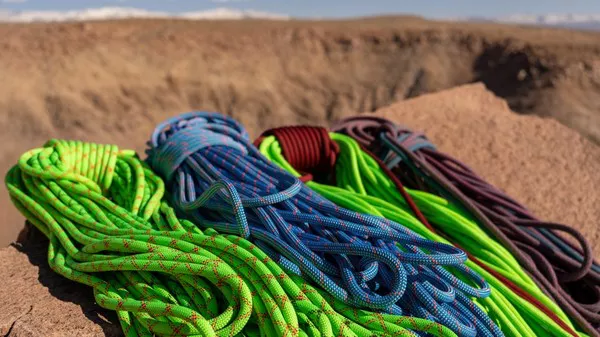Climbing ropes are a fundamental piece of equipment for any climber, offering a lifeline of security during ascents and descents. The modern climbing rope is a result of decades of innovation and material science, designed to withstand immense forces while remaining lightweight and durable. In this article, we delve into the intricate world of climbing ropes, exploring the materials they are made of, their construction methods, and the critical safety considerations that govern their design.
The Evolution of Climbing Rope Materials
The history of climbing ropes is marked by a progression from natural fibers to synthetic materials, driven by the need for enhanced strength, flexibility, and reliability. Early ropes were typically crafted from hemp or manila fibers, offering a degree of strength but susceptible to weathering and degradation. The transition to synthetic fibers in the mid-20th century revolutionized climbing rope technology.
One of the pioneering synthetic materials used in ropes was nylon. Nylon ropes demonstrated superior strength and durability compared to natural fibers, making them a preferred choice among climbers. However, nylon ropes had limitations in terms of elongation and shock absorption, which led to further advancements in rope technology.
The introduction of kernmantle construction in climbing ropes represented another significant leap forward. Kernmantle ropes consist of a core (kern) surrounded by a sheath (mantle), combining the strength and flexibility of synthetic fibers with enhanced protection against abrasion and cutting. This construction remains the standard for modern climbing ropes.
Materials Used in Modern Climbing Ropes
Contemporary climbing ropes are primarily composed of synthetic fibers, carefully engineered to optimize performance and safety. The most common materials used in modern climbing ropes include:
1. Nylon: Nylon remains a staple material in climbing ropes due to its high strength-to-weight ratio and durability. It provides excellent resistance to abrasion and UV exposure, crucial for outdoor climbing. Nylon ropes are known for their reliability and versatility across different climbing disciplines.
2. Polyester: Polyester fibers are valued for their low stretch properties, making them ideal for static or low-stretch ropes used in certain climbing applications like top-roping or anchoring. Polyester is also resistant to moisture absorption, ensuring consistent performance in varying weather conditions.
3. Dyneema® (HMPE): High Modulus Polyethylene (HMPE) fibers, such as Dyneema®, offer exceptional strength and minimal stretch. Ropes incorporating Dyneema® are renowned for their lightweight nature and high tensile strength, making them popular for specialized climbing scenarios like alpine climbing and mountaineering.
4. Technora® and Aramid Fibers: These high-performance fibers are known for their heat resistance and strength. Ropes featuring Aramid fibers like Technora® are utilized in specialized applications where resistance to heat and abrasion is paramount, such as in industrial or high-temperature climbing environments.
Construction of Climbing Ropes
The construction of climbing ropes is a meticulous process aimed at balancing strength, flexibility, and durability. Kernmantle ropes are composed of distinct layers:
1. Core (Kern): The core of a climbing rope provides its primary strength and impact absorption capabilities. Cores are typically constructed from a combination of nylon, polyester, or Dyneema® fibers. The design and layout of the core dictate the rope’s dynamic properties, including elongation and impact force rating.
2. Sheath (Mantle): The sheath of a climbing rope serves as a protective layer for the core, shielding it from abrasion, moisture, and UV exposure. Sheaths are woven from tightly braided fibers, often nylon or polyester, to enhance durability and grip. The thickness and density of the sheath impact the rope’s handling characteristics and resistance to wear.
Modern climbing ropes often feature additional treatments or technologies to improve performance and safety:
3. Dry Treatment: Many climbing ropes undergo a specialized dry treatment process to repel water and moisture. Dry-treated ropes are essential for ice climbing, mountaineering, or wet weather conditions where moisture absorption can compromise a rope’s strength and handling.
4. Middle Mark: A colored mark placed at the midpoint of the rope aids in identifying the center, facilitating safer rappelling and lowering maneuvers.
Safety Considerations and Standards
Climbing ropes are subject to stringent safety standards and certifications to ensure their reliability in critical situations. The International Climbing and Mountaineering Federation (UIAA) and other regulatory bodies establish guidelines for rope construction, testing, and performance. Key safety considerations include:
1. Dynamic Properties: Climbing ropes are designed to stretch under load to absorb energy during falls, reducing impact forces on the climber and anchor points.
2. Impact Force Rating: This metric measures the maximum force transmitted to the climber during a fall. Lower impact force ratings indicate greater shock absorption and safety.
3. Static Strength: The ability of a rope to withstand a static load without breaking is crucial for anchoring and belaying.
4. UIAA Falls: Ropes are tested for their ability to withstand a specified number of standardized falls, simulating real-world climbing scenarios.
5. Inspection and Retirement: Climbing ropes must be regularly inspected for signs of wear, abrasion, or damage. Retirement criteria based on usage, age, or visible wear ensure climbers retire ropes before they become unsafe.
Conclusion
The composition of climbing ropes reflects a harmonious blend of advanced materials, precise engineering, and rigorous safety standards. From humble beginnings with natural fibers to cutting-edge synthetic constructions, climbing ropes have evolved into sophisticated lifelines that empower climbers to push their limits with confidence. Understanding the materials and construction behind climbing ropes is not only enlightening but essential for ensuring safe and enjoyable climbing experiences. As technology advances and new materials emerge, the future promises further innovations that will continue to elevate the performance and safety of climbing ropes for adventurers worldwide.

